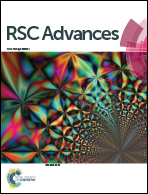Two novel potent ACEI peptides isolated from Pinctada fucata meat hydrolysates using in silico analysis: identification, screening and inhibitory mechanisms†
Abstract
The aim of this study was to discover potent angiotensin-converting enzyme (ACE) inhibitory (ACEI) peptides from Pinctada fucata (P. fucata) for treating hypertension and to characterize them using in silico analysis. The P. fucata proteins were hydrolyzed by Alcalase®, a serine endopeptidase with broad selectivity, at various times (0, 2, 4, 6, 8, 10 h). The degree of hydrolysis (DH) and ACEI activity of the different hydrolysates were measured. Considering the molecular weight and ACEI activity, the 10 h hydrolysate was purified by a series of traditional separation methods, including ultrafiltration, gel G-25 chromatography, and reversed-phase high-performance liquid chromatography (RP-HPLC), with ACEI activity as a guide. The results showed two fractions, C17 and C18, eluted by means of semi-preparative RP-HPLC, and showed the highest ACEI activities of 80.33 ± 2.70% and 81.66 ± 0.29%, respectively, at 1 mg mL−1. The two fractions were then identified using liquid chromatography-electrospray ionization-tandem mass spectrometry (LC-ESI-MS/MS) and their MS/MS spectra data were subjected to de novo sequencing. Subsequently, the potential ACEI peptides were screened by in silico methods, namely, to analyze the average local confidence (ALC) value obtained from the sequencing software and the P-value from the Pepsite 2. In total, 13 potential ACEI peptide sequences were obtained and identified from the two fractions by LC-ESI-MS/MS, and two novel tetrapeptides, FRVW (607.3314 Da) and LPYY (555.2881 Da), were screened for synthesis according to the in silico analysis. The in vitro ACEI tests indicated that FRVW and LPYY had IC50 values of 18.34 and 116.26 μM, respectively. The Lineweaver–Burk plot showed that FRVW was a noncompetitive inhibitor, and LPYY was shown to be a mixed-mode type inhibitor. A stability study against ACE indicated that both peptides were hydrolyzed by ACE to some extent, the higher ACEI activity following incubation with ACE indicating that they should be classified as pro-drug substrates. Molecular docking results showed that hydrophobic amino acids (HAAs) within peptides formed vital interactions including hydrogen bonds, electrostatic forces, van der Waals forces and Pi–Pi interactions with ACE residues, which stabilized the enzyme–peptide complex. Furthermore, the docking results accorded with the inhibition kinetic mode. Our study demonstrated that FRVW and LPYY isolated from P. fucata have potential applications as antihypertensive agents.



 Please wait while we load your content...
Please wait while we load your content...